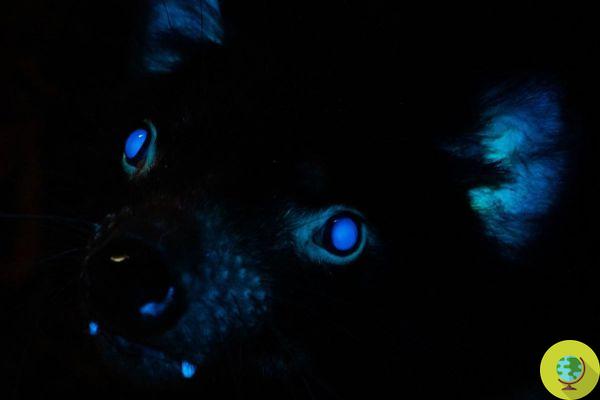
Not just wombats. Tasmanian devils also glow in the dark becoming biofluorescent. Here because
Not just wombats. Tasmanian devils also glow in the dark becoming fluorescent. A chance discovery that fascinated the authors of him. It is in fact the first documented case of biofluorescence in these animals.
Nature will never cease to amaze us. Biofluorescence refers to the phenomenon by which a living organism absorbs light and re-emits it as a different color. In the case of the Tasmanian devil, the skin around the muzzle, eyes and inner ear absorbs ultraviolet light, invisible to the human eye, and re-emits it as visible blue light. It is unclear whether this example of biofluorescence has an ecological purpose or is simply a coincidence.
La biofluorescence has recently been discovered in other Australian mammals such as the platypus and recently in vombato. Virginia possums native to Ohio and southern flying squirrels also fluoresce under UV light. Although the reasons for biofluorescence in mammals have yet to be determined, the hypotheses are varied. Evidence seems to suggest that some bird species use UV fluorescence to attract mates. Many fish even use biofluorescence for camouflage.
It is also possible that Tasmanian devils developed biofluorescence due to their mainly nocturnal habits.
“Even if biofluorescence is present in nature and detectable by a species, it should also influence its behavior for it to be considered a functional adaptation. Although caution is needed in interpreting these results, one thing is certain: the Tasmanian devil lives up to his name in all light spectra ”explain the authors of the discovery.
Difference between biofluorescence and bioluminescence
Biofluorescence should not be confused with bioluminescence, which is triggered by a chemical reaction and can occur even in the complete absence of external light. A classic example of bioluminescence is given by fireflies and deep-sea marine fauna.
Biofluorescence, on the other hand, occurs when a living being absorbs high-energy radiation such as ultraviolet and then emits light at a lower frequency. Many proteins have been identified that can do this in skin or other animal tissues, including bones and teeth.
The Toledo Zoo is excited to report the first documented case of biofluorescence in Tasmanian devils! Biofluorescence…
Posted by The Toledo Zoo on Saturday, December 5, 2020
Too bad, however, that the discovery took place inside the Toledo Zoo, Ohio.
Sources of reference: Toledo Zoo / Facebook
READ also:
- The platypus is bioluminescent, its fur glows green-blue under UV light. I study
- Biofluorescent turtle discovered that turns red and green (VIDEO)
- These tiny frogs glow to mate and defend against predators (VIDEO)


























